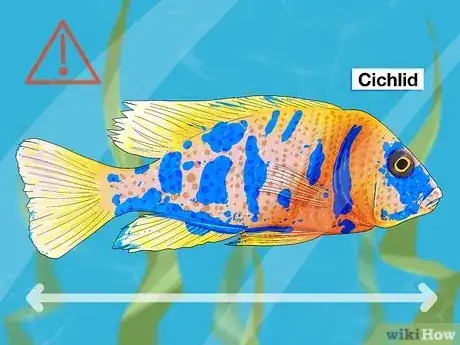This article was co-authored by Deanne Pawlisch, CVT, MA. Deanne Pawlisch is a Certified Veterinary Technician, who does corporate training for veterinary practices and has taught at the NAVTA-approved Veterinary Assistant Program at the Harper College in Illinois and in 2011 was elected to the board of the Veterinary Emergency and Critical Care Foundation. Deanne has been a Board Member of the Veterinary Emergency and Critical Care Foundation in San Antonio, Texas since 2011. She holds a BS in Anthropology from Loyola University and an MA in Anthropology from Northern Illinois University.
There are 7 references cited in this article, which can be found at the bottom of the page.
This article has been viewed 69,866 times.
The task of filling a freshwater tank with fish can seem daunting. If this is your first time populating a freshwater fish tank, you may feel overwhelmed by the sheer number of fish you can choose from. To populate the tank, you'll need to find breeds of fish that, when fully grown, will fit comfortably in the fish tank. Also select species of fish that will be compatible with one another in the tank, to avoid any territorial conflicts between fishes. Purchase fish for your aquarium at a local and fish-knowledgeable pet store, or from a reputable online site.
Steps
Selecting Species of Fish
-
1Choose fish that will fit in your aquarium. If you already have an aquarium, you can use its size to help inform your decision regarding which fish to purchase. Do a little online research—or talk to knowledgeable sales staff at a pet store—to see how large specific species of fish will grow to be.[1]
- Although juvenile fish you see in pet stores may be small, as they grow, many species will become quite large. Some freshwater aquarium fish can be over a foot long!
- Some fish need a lot of space or live in a school that won't fit in your aquarium.
-
2Start out with fish that are easy to maintain. If you're a beginner fish owner, make sure to avoid species that are notoriously difficult to care for. Although fish are a relatively low-maintenance type of pet, some species are difficult to keep alive and demand more of your time and energy than other species.
- Breeds of fish that are easy to maintain include the tetras, betta fish (although these cannot be kept in a tank with other fish), some breeds of barbs, mollies, guppies, small catfish, and platies.[2]
- For example, discus are considered to be a challenging breed of fish. They like pristine water, so you'll need to change their water twice a week. Discus can also carry diseases more commonly than other fish.[3]
- Gourami fish species are one of the options to start with. Gouramis are very hardy and easy-care species of fish that you can keep as a beginner. You can choose opaline gourami, powder blue gourami, or honey gourami.
Advertisement -
3Fill your tank with behaviorally compatible fish. Not all breeds of fish will do well together in the same fish tank. In order to set up a healthy environment in your tank, select breeds that will get along well together.[4] If you're planning to have a community aquarium with many breeds of fish, aggressive fish (like the betta) are not a good option.
- For example, danios, platies, swordtails, and mollies are all compatible with one another, and also with many species of tetras.
- Another group of compatible fish includes neon or glowlight tetras, glass fish, guppies, and ghost shrimp.
Building a Community Tank
-
1Include fish with similar water-temperature requirements. Freshwater fish tanks are either cold-water or warm-water. If you are planning a community tank, make sure the species you plan on putting together have similar temperature requirements. For example, don't put goldfish, which are cold-water fish, in a tank with tropical fish like bettas (which require warm water).
- Beginner-friendly cold-water fish include goldfish, tetras, and the White Cloud minnow.
- Beginner-friendly warm-water fish include Danios, the Black Molly, Platies, Swordtails, and the Black Skirt Tetra.
-
2Include fish with similar feeding requirements. If you're planning to have many species of fish living in the same aquarium, they should all be able to eat the same type(s) of food. Most breeds of “beginner”-level freshwater fish can be fed with a jar of fish food flakes.
- Catfish, however, do not eat fish food flakes. They are scavengers, and primarily eat food and organic matter that have fallen to the bottom of the aquarium.[5]
- For example, some fish eat only live food, like the knifefish. Both the Jack Dempsey and the Bolivian Ram prefer to eat live foods, such as blood worms.[6]
- Some fish may eat invertebrates (which can be expensive), or may even devour your other fish.
-
3Do not put territorial fish in a full aquarium. Territorial fish tend to claim a section of the aquarium (or a specific piece of decoration inside the tank) as their own, and will attack other fish who inadvertently draw near. If you do plan to purchase one or more fish of a territorial breed, they will need extra space in the aquarium.[7]
- Territorial species include breeds of Cichlids, and the Jack Dempsey.[8]
Choosing Individual Fish
-
1Visit a local pet store. Many species of freshwater fish are sold at pet stores. If you can find a pet store that specializes in fish, you'll be able to speak with the knowledgeable sales staff. They can often provide better information than employees from stores that sell all kinds of pets. [9] Ask for their recommendation if you have any lingering questions about which fish to fill your tank with.
- Local pet stores will likely not carry rare, expensive, or exotic fish. If a specific fish you've wanted is hard to find, consider getting a more common fish.
- If you do not have a reputable pet store in your vicinity, consider purchasing fish online. Use an established pet site, like PetSolutions, PetCo, or LiveAquaria.
-
2Avoid buying a male and female of the same species. If you end up with a sexually compatible male and female in the same tank, they are likely to breed with one another. For example, guppies breed often and produce large numbers of offspring. Keeping male and female guppies separate can solve this potential problem.[10]
- If you do buy a male and female of the same species, ask a knowledgeable staff member at a pet store the breeding pair are likely to be aggressive with other fish.
-
3Purchase only healthy fish. Never purchase sick fish, as they are likely to die shortly after you buy them. Healthy fish will display normal behavior and bright colors typical of their species. If you notice any fish with ulcers or boils, bulging eyes, or discolored scales, it’s probably in a poor state of health.[11]
- If a sick fish has a communicable illness, and you add it to a tank of healthy fish, you're putting all of the other fish in your tank at risk of illness and possible death.
References
- ↑ http://www.liveaquaria.com/PIC/article.cfm?aid=159
- ↑ https://www.earthsfriends.com/freshwater-aquarium-fish/
- ↑ http://aquafind.com/articles/CaringForDiscusFish.php
- ↑ http://aquariumfish.net/information/how_to_choose_fish.htm
- ↑ http://www.liveaquaria.com/PIC/article.cfm?aid=159
- ↑ https://www.earthsfriends.com/freshwater-aquarium-fish/
- ↑ http://www.tfhmagazine.com/aquarium-basics/fish-selection--stocking-guide.htm
- ↑ http://fishkeepingadvice.com/13-best-freshwater-fish/
- ↑ http://www.tfhmagazine.com/aquarium-basics/fish-selection--stocking-guide.htm






































































